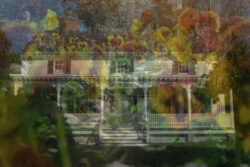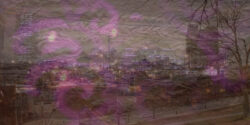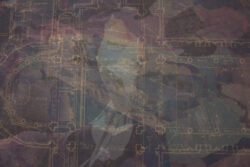Christine Stoddard is a writer and visual storyteller. She is a Southeast Review featured artist, a Puffin Foundation emerging artist, and the founding editor of Quail Bell Magazine. Previously, her films have been screened at the New York Transit Museum, Videology, the Edgar Allan Poe Museum, and other venues. Her book, Images of America: Richmond Cemeteries (Arcadia Publishing), was published last September.
Tell us a little about yourself.
Well, my name’s Christine Stoddard and I was born and raised in Arlington, Virginia. Today I live about five miles from where I grew up, but I spent a spell in France, Scotland, and, the weird city that will always have my heart, Richmond, VA, before returning to my old stomping grounds. Now I’m in hibernation mode, so when I’m not creating in my home studio (which is a studio, ha), I’m usually still at home, reading ethnographic theory for my graduate folklore program—from the comfort of my own bed, natch.
I identify as a writer and visual storyteller, which gives me the freedom to attempt any number of art forms, from poetry to comics to film. I’m also the founding editor of Quail Bell Magazine, an online and occasional print publication dedicated to real and unreal stories from around the world. Quail Bell has gotten shoutouts from the likes of Time Out New York, Vol. 1 Brooklyn, and Washington Post Express. Last fall, I had the privilege of being named one of Folio Magazine‘s “top 20 media visionaries in their 20s” for founding Quail Bell Press & Productions, the publishing company behind Quail Bell Magazine and other projects.
My work has appeared or is forthcoming in the New York Transit Museum, The Feminist Wire, the Annapolis Fringe Festival, Every Day Fiction, the Side of Eye Experimental Film Festival, the Poe Museum, The Southeast Review, Bunker Projects, Figment DC, Les Femmes Folles, and elsewhere. I’ve been fortunate to meet some people who really believe in my work, and that faith has led to some exposure. Right now I’m excited about finishing the manuscript for my nonfiction book, The Hispanics of Virginia (The History Press), and marrying the man I love in May. I can only hope that my creations will continue to find homes in the world.
What’s your main inspiration behind your work?
Broadly, the inspirations in almost any of my works are history, folklore, and memory. The impetus is often, but not always, social justice. The pulse is feminist magic.
What drew you to create this gallery?
This gallery represents a handful of the dozens of digital collages I’ve created since high school. I make the collages using my original photographs and occasionally scanned drawings. Often I photograph subjects out in the world, but other times I’ll make a 2D or 3D piece and photograph it to incorporate into a collage. I also create traditional paper collages, but I have no preference for digital over traditional. Both have their advantages and disadvantages. WriterHouse in Charlottesville, VA will be exhibiting canvas prints of my favorite digital collages this May. “Des Fées” will be my first solo show in about five years, but I think I’m ready.
What are your biggest hopes for your artwork?
To stir, quicken, and delight— and then to spark change.





